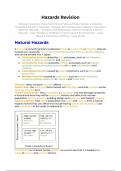Summary
Summary AQA A Level Geography: Hazards Detailed Notes
Full, detailed, A* level notes about the Hazards topic in the Geography A Level. Case studies included. Clear and concise notes to help you build knowledge on the topic and achieve higher grades. Send me a message if you have any questions about what is in the document!
[Show more]












